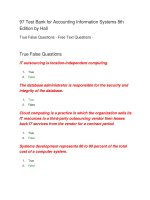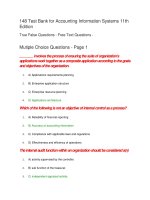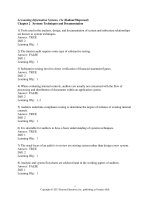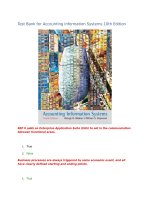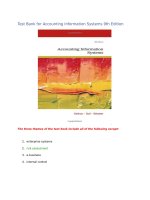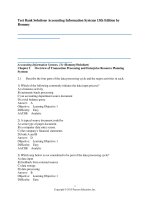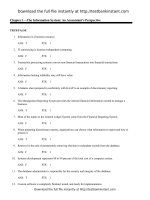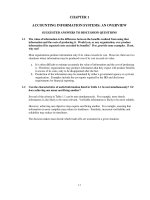Solution manual for accounting information systems 11th edition by bodnar download
Bạn đang xem bản rút gọn của tài liệu. Xem và tải ngay bản đầy đủ của tài liệu tại đây (688.37 KB, 27 trang )
Solution Manual for Accounting Information Systems 11th
Edition by Bodnar
Chapter 2
SYSTEMS TECHNIQUES AND DOCUMENTATION
TEACHING TIPS
I normally introduce flowcharting symbols with simple examples on the board. I
first introduce a very simple manual flowchart involving only three symbols. An
example would be the preparation of a sales order. This would show a customer
order coming into the process and a completed sales order coming out. Then I
mention how computer symbols could be added.
From experience, I have discovered that the single most important thing for
students to learn in analytical flowcharting is the sandwich rule. About 90% of all
mistakes seem to involve a violation of this rule. The second largest problem
involves separating various functions (e.g., sales, credit, shipping, and so on) into
columns.
I've discovered students all seem to do about the same when I place complicated
flowcharting problems on exams. For this reason, I now ask mostly short answer
questions about flowcharting on exams.
I've found it important to emphasize the distinction between the types of
documentation tools used by systems developers and auditors.
With logical data flow diagrams (DFD), it's interesting to discuss how developers
go from an existing system to a new system. They begin with an existing analytical
flow chart, turn it into a DFD, modify the DFD, and then generate a new analytical
flowchart.
It’s worth taking some time to discuss the BPMN, as this is used in Chapters 7-9
to document the basic transaction cycles.
11
12 2 Systems Techniques and Documentation
USERS OF SYSTEMS TECHNIQUES
Systems techniques are tools used in the analysis, design, and documentation of
system and subsystem relationships. They are used by accountants who do systems
work, either internally for their company or externally as consultants or auditors.
Most auditing engagements are divided into two basic components: the interim
audit, which involves internal control evaluation, and the financial statement audit,
which involves substantive testing. Substantive testing is the direct verification of
financial statement figures, placing such reliance on internal control as the results
of the interim audit warrant.
Internal Control Evaluation. Analytic flowcharts, document flowcharts,
and forms distribution charts may be used by auditors to analyze the
distribution of documents in a system. Several other system techniques,
such as questionnaires and matrix methods, might also be used in the
evaluation of internal controls.
Compliance Testing. Auditors undertake compliance testing to confirm the
existence, assess the effectiveness, and check the continuity of operation of
internal controls on which reliance is to be placed.
Working Papers. Working papers are the records kept by an auditor of the
procedures and tests applied, the information obtained, and conclusions
drawn during an audit engagement. Auditors use systems techniques to
document and analyze the content of working papers. Internal control
questionnaires, analytic flowcharts, and system flowcharts appear frequently
in working papers because they are commonly used by auditors in the
evaluation of internal controls. Data flow diagrams, HIPO charts, program
flowcharts, branching and decision tables, and matrix methods might appear
in working papers if they are part of the documentation of a system that is
being reviewed.
Use of Systems Techniques in Systems Development
A systems development project generally consists of three phases: systems
analysis, systems design, and systems implementation.
Systems Analysis. Logical data flow diagrams and analytic flowcharts are
helpful in giving an overall picture with regard to transaction processing
within the organization.
Systems Design. Systems design formulates a blueprint for a completed
system.
Systems Implementation. Systems implementation involves the actual
carrying out of the design plan.
Systems Techniques and Documentation 2
13
Use of Systems Techniques by Sarbanes-Oxley Act Compliance Participants
System documentation is the underpinning support of the internal control and
process documentation requirements that have been set by the Sarbanes-Oxley Act
(SOX).
SYSTEMS TECHNIQUES
Flowcharts are probably the most common systems technique. A flowchart is a
symbolic diagram that shows the data flow and sequence of operations in a system.
Flowcharting Symbols. The basic symbols include the input/output symbol, the
process symbol, the flowline symbol, and the annotation, comment symbol. The
flowline symbol is used to link other symbols.
Specialized input/output symbols may represent the I/O function and, in
addition, denote the medium on which the information is recorded, or the
manner of handling the information, or both. If no special symbol exists, the
basic I/O symbol is used.
Specialized process symbols represent the processing function and, in
addition, identify the specific type of operation to be performed on the
information. If no specialized symbol exists, the basic process symbol is
used.
The additional symbols are used to clarify a flowchart or to make the
flowcharting of a complete process more convenient.
Symbol Use in Flowcharting
Normal direction of flow is from left to right and top to bottom.
IPO and HIPO Charts
IPO and HIPO charts are used primarily by systems development personnel. A
HIPO chart contains two segments: the hierarchy chart that factors the processing
task into various modules or subtasks and an IPO chart to describe the inputprocess-output requirements of each module. The hierarchy chart describes the
overall system and provides a "table of contents" to the detailed IPO charts,
usually through a numbering scheme.
Systems and Program Flowcharts
Systems flowcharts are associated with the analysis phase of a systems project and
program flowcharts with the design phase. A program flowchart is the design step
between overall system design and coding the system for computer processing.
A systems flowchart identifies the overall or broad flow of operations in a
system.
14 2 Systems Techniques and Documentation
A program flowchart (also called a block flowchart) is more detailed
concerning individual processing functions than a systems flowchart. Each
of the processing functions depicted in a systems flowchart is further
detailed in a program flowchart, similar to the successive layering of IPO
charts in HIPO.
Logical Data Flow Diagrams
Logical data flow diagrams or data flow diagrams (both abbreviated as
DFD) are used by systems analysts to document the logical design of a
system to satisfy the user's request.
There are four DFD symbols. The terminator is used to indicate a source or
a destination of data. The process indicates a process that transforms data.
The data store is used to indicate a store of data. The data flow is used to
indicate a flow of data. Although these terms and symbols are
representative, many variations exist.
Structured Analysis. DFD typically shown in layers of increasing detail,
with the DFD in each layer being linked to each other.
Analytic, Document, and Forms Distribution Flowcharts
Analytic flowcharts, document flowcharts, and forms distribution charts may be
used to analyze the distribution of documents in a system.
An analytic flowchart identifies all significant processing in an
application, emphasizing processing tasks that apply controls.
A document flowchart is similar in format to an analytic flowchart but
contains less detail about the processing functions.
A forms distribution chart illustrates the distribution of multiple-copy
forms within an organization.
Analytic Flowcharting Illustration
Planning the Flowchart. Flow is from top to bottom and left to right.
Symbol Selection. For manual system, only several symbols are needed;
symbols for documents, files, and processes are the most commonly used
symbols.
System Analysis. One must first understand the system to be flowcharted.
Drawing the Flowchart
Sandwich Rule. Every process symbol should have its inputs and
outputs clearly specified.
Use of Connector Symbol. This symbol is used to terminate the flowchart
and then continue it on another page or in a different column. EntityColumn Relations. Columns in the flowchart typically represent
individuals or departments. This is something that beginners often have
Systems Techniques and Documentation 2
15
difficulty with.
Unified Modeling Language (UML)
UML is a technology that assists in the specification, visualization, and
documentation of models developed to structure and design software systems.
UML uses a variety of graphical techniques to model different aspects and views
of software development projects at various levels of abstraction. In addition to
techniques used to model the specifics of software development, UML includes
techniques that are the functional equivalent of data flow diagrams, document
flowcharting, and analytical flowcharting. UML version 2.0 defines thirteen types
of diagrams, divided into three categories: structure diagrams, behavior diagrams,
and interaction diagrams. When used to model business processes, the graphical
techniques used in UML to prepare activity diagrams can result in diagrams that
are very similar to analytic flowcharts.
Business Process Diagrams
The Business Process Diagram (BPD) is a graphical representation of a business
process. It focuses on the sequence of activities that constitute a business process,
and also on the related business logic that guides that sequence of activities.
Business Process Modeling and Notation (BPMN) is a widely accepted standard
for modeling business processes using BPDs. Similar to UML, BPMN is a
computer industry specification standard developed and supported by the OMG, a
nonprofit computer industry consortium. BPMN is similar to UML but differs in
that BPMN is a process-oriented approach to modeling whereas UML is an objectoriented approach. Where BPMN has a focus on business processes, UML has a
focus on software design.
Narrative Techniques
Interviews are useful for familiarizing the analyst with decision makers and their
problems. Depth interviews allow the systems analyst to establish a personal
working relationship with the manager. Open-ended questionnaires are a factgathering technique where persons provide written answers to general, rather than
specific, questions. Narrative techniques also include document reviews.
Resource Utilization Analysis
Flowcharts do not show the resources required to operate the system. Such
resources must be considered both by the auditor and systems persons.
Work Measurement
Work measurement includes the variety of techniques used to model, measure, or
estimate clerical or other activities in a production framework. In an accounting
16 2 Systems Techniques and Documentation
framework, work measurement is similar to the concept employed in standard cost
systems.
Work Distribution Analysis
Work distribution analysis studies the assignment of specific tasks to employees.
A task list is typically used to record each separate item of work performed by an
individual and the average number of hours spent on each task per week.
Decision Analysis Techniques
Branching and Decision Tables are used primarily by systems development
personnel. Often the decision logic required in a computer program is sufficiently
complex to mitigate the usefulness of the standard decision flowcharting symbol.
In such cases, a branching table may be used to depict a decision function. A
decision table is a tabular representation of a decision-making process. It is
similar to a branching table but more complex in that it incorporates multiple
decision criteria. Decision tables are constructed on an IF-THEN premise and
appear as a two-dimensional matrix in general form.
Matrix Methods. Matrix methods are used by both auditors and systems
personnel to present large volumes of data. The "work" or "spread" sheets used in
accounting systems to spread or distribute account balances through different subclassifications or to facilitate the closing process are common examples of matrix
techniques.
Software for Systems Techniques
A variety of software tools can be used to create flowcharts and other graphical
systems techniques.
Microsoft Office® Applications. Microsoft Visio® is a Microsoft Office®
application that is targeted at the creation of flowcharts and other graphical
diagrams. Microsoft PowerPoint® is a general presentation tool that
contains specific drawing features that may be used to create flowcharts and
other graphical diagrams. These same drawing tools are also available in
both Microsoft Word® and Microsoft Excel®, allowing either of these
general software applications to be used to prepare graphical diagrams and
flowcharts.
Computer-Aided Software Engineering (CASE). Computer-aided
software engineering (CASE) is the process of using computer software
technology that supports an automated engineering discipline for software
development and maintenance.
UML Modeling Tools. A variety of software tools to draw UML charts are
available from vendors. Professional UML software is similar to CASE in
Systems Techniques and Documentation 2
17
its objectives and its potential benefits in that it integrates UML charts with
other aspects of systems development, such as database design and code
generation.
REVIEW QUESTIONS
1.
A flowchart is a symbolic diagram that shows the data flow and sequence of
operations in a system.
2.
The basic symbols include the input/output symbol, the process symbol, the
flowline symbol, and the annotation, comment symbol. See Figure 2.1 for the
symbols.
3.
Flowchart symbols represent the physical aspect of a system.
4.
An IPO chart provides very little detail concerning a processing function,
but is a useful technique for analyzing overall information requirements.
Additional processing detail is provided by HIPO charts. A HIPO consists of a
series of charts that represent systems at increasing levels of detail, where the level
of detail depends on the needs of users.
5.
An analytic flowchart is similar to a systems flowchart in level of detail and
technique, but is organized by columns.
6.
A logical data flow diagram can be used to document the logical aspect of a
system.
7.
Auditors use analytic flowcharts in the evaluation of internal controls.
8.
Organization of the chart by columns is common to analytic, document, and
forms distribution charts.
9.
There are four symbols. The terminator is used to indicate a source or a
destination of data. The process indicates a process that transforms data. The data
store is used to indicate a store of data. The data flow is used to indicate a flow of
data. See Table 2.1 for the symbols.
10. No, flowcharting is not useful in analyzing the resources required to
implement a system.
11.
Work measurement is useful in evaluating the technical feasibility or
18 2 Systems Techniques and Documentation
technical requirements of a system design.
12. A work distribution analysis requires detailed information about functions
and responsibilities. A task list is used to record each separate item of work
performed by an individual and the average number of hours spent on each task
per week. Each employee (or department, and so on) is represented by a column;
the work assignments are spread across the table to employees. The method of
assignment should be rational; that is, employee qualifications, internal control,
scheduling, timing of events, and so forth should be considered.
Systems Techniques and Documentation 2
19
ANSWERS TO DISCUSSION QUESTIONS AND PROBLEMS
13. - 18. Multiple-Choice (CPA)
13. B
14. C
15. D
16. D
17. C
18. C
Varies
19. Systems Design - 30 minutes Hard
This problem provides an opportunity for the student to appreciate the data
processing requirements of transactional data. Many students will not appreciate
the amount of effort necessary to manually develop the 21 desired subtotals. There
are a variety of solutions, including going through the initial batch 21 times for 21
subtotals. The data processing steps required (and overall efficiency) depend on
the approach taken. Experience has shown that many student-generated solutions
are not effective: examined in detail they fail to generate the 21 subtotals.
A suggested solution is as follows:
(1) Sort the batch of invoices into 2 piles: invoices showing only product 1 sales
and those invoices with product 2 and/or 3 sales.
(2) Sort the pile of invoices containing only product 1 sales by customer. Calculate
daily sales totals for each customer. Calculate the grand total. Post (transcribe)
these subtotals to the worksheet.
(3) Sort the pile of invoices with product lines 2 and/or 3 sales by customer. Either
go through each customer pile twice, calculating each required subtotal; go
through each pile once, accumulating two subtotals concurrently (this is not
possible using a single calculator or with a single adding machine as two totals are
being accumulated); or re-sort each pile into 3 piles: product 2 only, product 3
only, and mixed. Calculate subtotals for each customer and transcribe to the
worksheets. (Note: the mixed invoices have to be examined when calculating both
line 2 and line 3 subtotals.)
20 2 Systems Techniques and Documentation
20. Analytic Flowchart; Data Flow Diagram - 45 minutes Medium
a.
analytic flowchart
Systems Techniques and Documentation 2
b.
data flow diagram
21
22 2 Systems Techniques and Documentation
21. Use of Systems Techniques - 10 minutes Easy
It is not uncommon to have to deal with difficult clients. If things are really
difficult, you can simply withdraw from the engagement. But if you are billing her
by the hour, then you can politely remind her that she can save herself a lot of
money by facilitating your work in a way that will permit you to finish at the
earliest possible date. There is also the option of bypassing Marjorie Renwald and
working directly with her two employees. As far as systems techniques go, the
usual ones will be needed: narratives, questionnaires, flowcharts, and internal
control summaries.
22. Data Flow Diagram - 10 minutes Easy
1.
No source is indicated for the user ID.
2.
There are two unlabeled flowlines in the diagram.
3.
A direct access storage device symbol, which represents a physical storage
medium, is used to represent the valid ID data in the diagram.
23. Flowchart Symbols; Technique - 30 minutes Medium
(a) CPA Examination, Unofficial Answer
1.
Time cards.
2.
Prepare batch-control slips.
3.
Batch-control slips (the numbers 1 and 2 should be added to indicate first
and second copy).
4.
Time cards.
5.
Input.
6.
Batch-control slip (the number 1 should be added to indicate first copy).
7.
Time cards.
8.
By batch.
9.
Payroll transaction file.
10. Sort by employee number within batch.
11. Master employee file.
12. Edit and compare batch total hours and number of employees.
13. Batch listing and exception report.
14. Payroll transaction file.
15. Exceptions noted: a. Unbalanced batch
b. Invalid employee number
16. Resolve differences.
(b)
1.
2.
3.
Advantages of a flowchart:
It insures a more comprehensive survey since incomplete information is
more evident when it is being recorded on flowcharts.
It is readily tailored to specific client system.
It enables the system to be more quickly understood by the audit staff since
Systems Techniques and Documentation 2
4.
5.
6.
7.
23
the information is presented in a concise, graphic manner which is easy to
comprehend and visualize.
It creates more interest on the part of the audit staff because they can better
appreciate the functioning of the system and hence the reasons for tests.
It produces more valuable and realistic recommendations to clients on
internal controls and system efficiency because of increased awareness of
accounting systems, relationships, and document flows.
It emphasizes those areas of the internal control system (and related
accounts) which require more or less attention and therefore assists in better
use of audit time.
It increases client goodwill because new audit staff members usually require
less time for system orientation, and interference with the client's staff is
kept to a minimum.
24 2 Systems Techniques and Documentation
24. Analytic Flowchart - 30 minutes Medium
Systems Techniques and Documentation 2
25. Analytic Flowchart - 30 minutes Medium
25
26 2 Systems Techniques and Documentation
26. Analytic Flowchart - 30 minutes Medium
Systems Techniques and Documentation 2
27. Analytic Flowchart - 1 Hour Hard
27
28 2 Systems Techniques and Documentation
28. Analytic Flowchart Symbols - 15 minutes Medium
CPA Examination, Unofficial Answer
Flowchart Symbol Internal Control Procedure
Letter
or Internal Document
c.
Approve customer credit and terms.
d.
Release merchandise to shipping department.
e.
File by sales order number.
f.
File pending receipt of merchandise.
g.
Prepare bill of lading.
h.
Copy of bill of lading to customer.
i.
Ship merchandise to customer.
j.
File by sales order number.
k.
Customer purchase order and sales order.
l.
File pending notice of shipment.
m.
Prepare three-part sales invoice.
n.
Copy of invoice to customer.
o.
Post to (or enter in) sales journal.
p.
Account for numerical sequence.
q.
Post to customer accounts.
r.
File (by payment due date).
29. Analytic Flowchart Symbols - 15 minutes Medium
CPA Examination, Unofficial Answer
A. Prepare purchase order
B. To Vendor
C. Prepare receiving report
D. From Purchasing
E. From Receiving
F. Purchase order No. 5
G. Receiving report No. 1
H. Prepare and approve voucher
I. Unpaid voucher file, filed by due date
J. Treasurer
K. Sign checks and cancel voucher package documents
L. Canceled voucher package
30. Decision Table - 30 minutes Medium
a. Limited Entry
1
Approved credit
2
N
3
Y
4
Y
Y
Systems Techniques and Documentation 2 29
Order < 25 units
Order is 26-50 units
Reject order
1
Approve order
5% discount
10% discount
Y
N
1
N
Y
1
2
2
N
1
30 2 Systems Techniques and Documentation
b. Extended Entry
1
N
Approved credit
Quantity ordered
% discount
Accept order
Reject order
x
2
Y
0-25
0
3
4
Y
Y
26-55 >56
5
10
x
x
x
31. Decision Table - 30 minutes Medium
a. Limited Entry
1
2
Is purchase less than $50
Y
Is purchase between $50 and $100
Is purchase over $100
Approve with no action
x
Give authorization number
Place hold on account
3
N
Y
Y
x
x
N
N
x
b. Extended Entry
1
2
3
Is purchase
less than $50 between $50 and $100 above $100
Approve with no action x
Give authorization number
x
x
Place hold on account
x
32. Work Measurement - 15 minutes Medium
Standard Time/check = (480 + 20 + 20) minutes / 570 checks = .912
minutes/check
Rest/delay/check = (20 + 20) minutes / 570 checks = .070 minutes/check
Rest/delay percentage = .070/.912 = 7.68%
While the above calculations are straightforward, the instructor might wish to
expand on some complexities related to the above type of calculations in actual
practice, such as ensuring valid and accurate sample sizes, ensuring realistic test
conditions, ensuring accurate count of rest and delay times, and the usefulness of
such averages in general.
Systems Techniques and Documentation 2
33. Analytic Flowchart - 1 Hour Medium
31
32 2 Systems Techniques and Documentation
34. Program Flowchart - 30 minutes Medium
Systems Techniques and Documentation 2
35. Program Flowchart - 30 minutes Medium
33
34 2 Systems Techniques and Documentation
36. Identify Flowchart Symbols -25
minutes Easy
Top Left to Right Symbol Name
Process
Alternate Process
Decision
Data
Predefined Process
Internal Storage
Document
Multi-document
Terminator
Preparation
Manual Input
Manual Operation
Connector
Off-page Connector
Card
Punched Tape
Summing Junction
Or
Collate
Sort
Extract
Merge
Stored Data
Delay
Sequential Access Storage
Magnetic Disk
Direct Access Storage
Display
37. Prepare Flowcharts Using Microsoft Office Flowchart Symbols - Varies
Systems Techniques and Documentation 2
35
The solutions to the problem are the flowcharts in the textbook that the student is
expected to reproduce using Microsoft Office flowchart symbols. These are Figure
2.17, Figure 2.18, and Figure 4.7. Figure 2.17 has 6 symbols and would not take
very long to reproduce. The other two figures would take much more time as
Figure 2.18 has 29 symbols in three columns and Figure 4.7 has 18 symbols in
three columns.
38. A.
D.
G.
event
sequence
pool
B.
E.
H.
activity
message flow
lane
I.
C.
gateway
F.
association
data object
39. Errors in the use of symbols in the BPD figure.
1. ‘authorize order’ symbol should be activity symbol (oval) not an event
symbol (circle)
2. message flow symbol (dashed line) should replace sequence flow symbol
(solid line) between ‘authorize order’ and ‘prepare order’
3. ‘customer database’ should be data object symbol, not event (diamond)
symbol
4. association symbol (dotted line) should replace solid line between ‘prepare
order’ and ‘customer database’
5. sequence flow line between ‘prepare order’ and ‘ship order’ should have
arrowhead going into ‘ship order’
6. association symbol (dotted line) should replace solid line between ‘ship
order’ and ‘shipping notice’
7. message flow symbol (dashed line) should replace sequence flow symbol
(solid line) between ‘ship order’ and ‘customer’ pool
40. Figure 8.8 in the textbook is the solution (i.e., correctly-prepared version of
problem figure). The three data objects should be connected with dotted
association lines to an activity symbol (oval) that encloses ‘process completed
transaction.’ Message flow symbols (dashed lines) should connect to the ‘accounts
receivable’ and ‘general ledger’ pools.
41. Business process diagram for Salt Company

